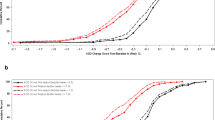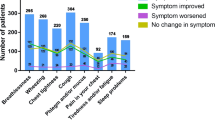Abstract
The Patient Satisfaction with Asthma Medication (PSAM) questionnaire was developed because no treatment satisfaction questionnaire could be identified that was comprehensive yet brief enough for use in clinical trials. Adult moderate asthmatics residing in Canada using an inhaled medication (either salmeterol, formoterol, or albuterol) self-administered the questionnaire, which also included the Asthma Quality of Life Questionnaire (AQLQ). A total of 53 asthmatics (70% female, 45% married, mean age: 47 years) completed the questionnaire. Using variable clustering, four PSAM scales were identified: Inhaler Properties, Comparison with Other Medications, Overall Perception of Medication, and Relief. Internal-consistency reliability provided evidence of reliability and lack of redundancy (Cronbach's Alpha: 0.82–0.88). Test-retest reliability was acceptable (ICC values at or near 0.70). As expected, interscale PSAM correlations were moderate to high; correlations between the PSAM and the AQLQ were low to moderate. To assess known groups validity, respondents were categorized by self-reported degree of asthma control: ‘very well controlled’ ‘somewhat controlled’, and ‘not well controlled’. Significant between-groups differences were found on all PSAM scales except Inhaler Properties. Patients categorized as ‘very well controlled’ tended to report highest PSAM scale scores. The PSAM questionnaire demonstrated reliability and validity in moderate asthmatics. Responsiveness should be assessed in future, prospective studies.
Similar content being viewed by others
References
McFadden ER Jr. Diseases of the respiratory system: Asthma. In: Fauci AS, Braunwald E, Isselbacher KJ, et al. (eds), Harrison's Principles of Internal Medicine. 14th edn, New York: McGraw-Hill, 1998: 1419–1426.
American Academy of Allergy and Immunology website. http://www.aaaai.org/default.htm Accessed 14 November 1998.
Juniper E, Guyatt GH, Ferrie PJ, Griffith LE. Measuring quality of life in asthma. Am Rev Respir Dis 1993; 147: 832–838.
Spilker B. Methods of assessing and improving patient compliance in clinical trials. In: Cramer JA, Spilker B (eds), Patient Compliance in Medical Practice and Clinical Trials. New York: Raven Press, 1991: 205–219.
Horn CR, Clark THH, Cochrane GM. Compliance with inhaled therapy and morbidity from asthma. Respir Med 1990; 84: 67–70.
Mahajan P, Ojamoto L. Patient satisfaction with the Diskhaler and the Diskus Inhaler, a new multidose powder delivery system for the treatment of asthma. Clin Ther 1997; 19(5): 1126–1134.
van der Palen J, Klein JJ, Kerkhoff AHM, van Herwaarden CLA. Evaluation of the effectiveness of four different inhalers in patients with chronic obstructive pulmonary disease. Thorax 1995; 50: 1183–1187.
Simons FE. A comparison of beclomethasone, salmeterol, and placebo in children with asthma. N Engl J Med 1997; 337: 1659–1665.
Osterman K, Stahl E, Kallen A. Bricanyl Turbuhaler in the treatment of asthma: A six week multi-centre study carried out in Sweden, the United Kingdom, Denmark, Norway, and Finland. Eur Respir J 1991; 4: 175–179.
Boe J, Stiksa G, Svensson K, Asbrink E. New method of evaluating patient preference for different inhalation delivery systems. Ann Allergy 1992; 68: 255–260.
National Asthma Education and Prevention Program. Expert Panel Report II: Guidelines for the Diagnosis and Management of Asthma. February 1997.
Weaver M, Patrick DL, Markson LE, Martin D, Frederic I, Berger M. Issues in the measurement of satisfaction with treatment. Am J Manag Care 1997; 3(4): 579–594.
Morisky DE, Green LW, Levine DM. Concurrent and predictive validity of a self-reported measure of medication adherence. Med Care 1986; 24(1): 65–74.
Ware JE Jr, Snow KK, Kosinski M, Gandek B. SF-36 Health Survey Manual and Interpretation Guide. Boston: The Health Institute, New England Medical Center, 1993.
Cronbach LJ. Coeffcient alpha and the internal structure of tests. Psychometrika 1951; 16: 297–334.
Deyo RA, Diehr P, Patrick D. Reproducibility and responsiveness of health state measures. Statistics and strategies for evaluation. Controlled Clin Trials. 1991; 12(suppl 4): 142S–158S.
Scientific Advisory Committee. Instrument review criteria. Medical Outcomes Trust Bulletin 1995, I–IV.
Leidy NK, Coughlin C. Psychometric performance of the Asthma Quality of Life Questionnaire in a US sample. Qual Life Res 1998; 7(2): 127–134.
Author information
Authors and Affiliations
Rights and permissions
About this article
Cite this article
Mathias, S.D., Warren, E.H., Colwell, H.H. et al. A new treatment satisfaction measure for asthmatics: A validation study. Qual Life Res 9, 873–882 (2000). https://doi.org/10.1023/A:1008913209828
Issue Date:
DOI: https://doi.org/10.1023/A:1008913209828




